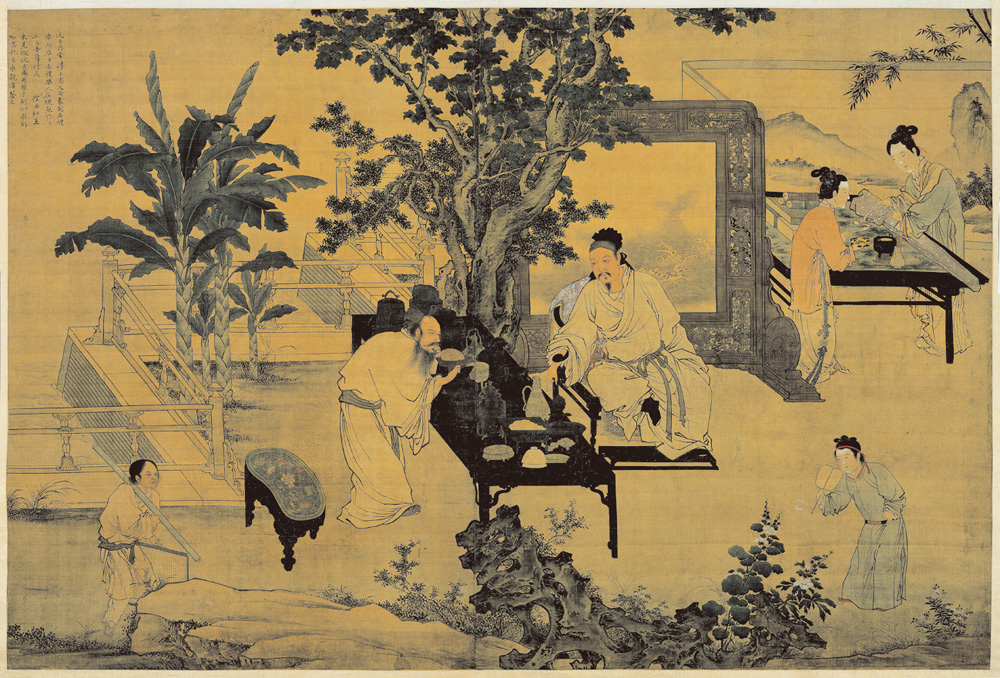Home >> Arts >> Painting >> Famous Chinese Paintings >> Du Jin: Enjoying Antiquities
Enjoying Antiquities (玩古圖)
Du Jin (杜堇, fl. ca.1465-1509), Ming Dynasty (1368-1644)
Hanging scroll, ink and colors on silk, 126.1 x 187 cm, National Palace Museum, Taipei
Du Jin had the style name Ju’nan (懼男) and the sobriquets Chengju (檉居), Gukuang (古狂), and Qingxia tingzhang (青霞亭長). A native of Dantu (modern Zhenjiang, Jiangsu), he was active in the middle of the Ming dynasty from around 1465 to 1509. Early in the Chenghua reign (成化, 1465-1487), he sat for the Presented Scholar court examination but did not place, gradually turning to become a literatus and professional painter taking up residence in Beijing. He also traveled around the Nanjing and Jiangsu regions, where he often associated with famous scholars and officials at the time. According to records in painting histories, Du Jin specialized in figure as well as ruled-line, landscape, and flower painting. His surviving works, however, deal mostly with figural and narrative subjects, demonstrating that he not only painted in the monochrome “baimiao (白描)” manner of delicate lines but also followed the colorful and exquisite fine-line style of the Southern Song Painting Academy figures. Du Jin’s works had a major impact on figure painting of the middle to late Ming dynasty, including the figural style of Tang Yin (唐寅, 1470-1523), who obviously was influenced by him.
“Enjoying Antiquities” is a representative example of Du Jin’s fine-line figure painting that also reflects the fashion for appreciating and judging ancient painting, calligraphy, and antiquities among literati and scholar-officials of the middle and later Ming dynasty. This painting depicts the corner of a garden built along a bank with water in the background. One of the two scholar-official figures is seated before a large ornamental standing screen as he views ancient bronzes and antiquities on the long table while the other carefully studies one of the pieces. To the lower right is a girl attendant holding a fan and playing with butterflies as another in the lower left approaches the scene with a large painting scroll and a “weiqi (圍棋)” (Go) game board. In the upper right are two ladies in a screened enclosure, one unwrapping a zither and the other preparing an incense burner. The furnishings depicted herein are all exquisite and opulent, reflecting the considerable wealth and taste of the host. This, however, was not the main point intended by Du Jin. As inscribed in five lines of elegant script in the upper left corner of the painting, he discusses “Enjoying Antiquities” on a more serious note:
Enjoying antiquities was common before, being studied for their high aspiration. By esteeming shapes and providing names, ritual and music are to be found within them. A day without ritual and music, and humanity would fall from grace. To perform and uphold them, this is what I have endeavored. [Signed] Chengju, Du Jin.
Inscribed together with “Painting of Enjoying Antiquities” requested by Jian Mian, I have here sought resemblance beyond form. Giving voice to my intention, may the viewer examine this.
玩古乃常。博之志大。尚象制名。禮樂所在。日無禮樂。人反塊(愧)然。作之正之。吾有待焉。檉居杜堇。柬冕徵玩古圖并題。予則似求形外。意托言表。觀者鑒之。
Du Jin felt that with the spirit of “studying antiquity” formed via the close examination of the forms and naming of ancient objects, as well as tracing and unraveling the system of ancient rituals and music, the enjoyment of curios pleasing to the eye could be transformed into a constructive act to lift the spirit, similar to what Confucius once said: “Be fond of antiquity and exert yourself in pursuing it (好古敏求).” In Du Jin’s painting, the scholar with a long beard gazing with a concentrated expression, along with the object he is studying, make this no ordinary painting of the Four Arts (zither, Go, calligraphy, painting) associated with the traditional scholar. Instead, it traces back to the ancient bronzes of the venerated Three Dynasties (Xia, Shang, and Zhou) of high antiquity, expressing the implied meaning behind Du Jin’s special design in the painting.
